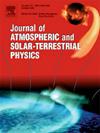利用长短期记忆网络对赤道和低纬度地区电离层不规则性的短时预报
IF 1.9
4区 地球科学
Q3 GEOCHEMISTRY & GEOPHYSICS
Journal of Atmospheric and Solar-Terrestrial Physics
Pub Date : 2025-02-17
DOI:10.1016/j.jastp.2025.106466
引用次数: 0
摘要
预测电离层状况对地基和天基无线电通信系统的操作效率越来越重要,以期补偿空间天气的影响。本研究的重点是在复杂多变的赤道电离层中预测电离层的不规则性,这对于优化天基应用至关重要。利用长短期记忆(LSTM)深度学习算法,建立了一个基于全球导航卫星系统(GNSS)数据的赤道电离异常(EIA)区域扰动预测模型。我们利用15年的数据(2005-2020)来训练、验证和测试模型的性能,并根据TEC指数(ROTI)值的每日和每小时变化率,以及相关系数(R)、决定系数(R2)和均方误差(MSE)等评价指标,对基线模型的结果进行评估。值得注意的是,LSTM预测模型在各个站点上的表现都优于基线模型,表现出更高的R和R2值,显著降低了MSE。这些结果表明LSTM模型在预测电离层扰动方面具有优越的精度,这对天基应用至关重要。残差的分布分析突出了LSTM模型更好地捕获目标变量中的潜在模式和可变性的能力。这项研究有助于加强空间应用的电离层预报模型,确保天基系统的可靠性。本文章由计算机程序翻译,如有差异,请以英文原文为准。
Short-time forecast of ionospheric irregularities using long short-term memory networks over equatorial and low-latitudes regions
Predicting ionospheric conditions is becoming increasingly important towards the operational efficiency of both ground-based and space-borne radio communication systems with a view to compensate for the effects of space weather. This study focuses on predicting ionospheric irregularities in the complex and variable equatorial ionosphere which is deemed critical for optimal space-based application. We utilized the Long-Short-Term-Memory (LSTM) deep learning algorithm to develop a predictive model for forecasting disturbances in the equatorial ionization anomaly (EIA) region using Global Navigation Satellite Systems (GNSS) data. We utilized fifteen-year worth of data (2005–2020) to train, validate and test the performance of the model and assessed the results against a baseline model relying on daily and hourly Rate of Change of TEC Index (ROTI) values and utilized evaluation metrics such as correlation (R), determination coefficient (), and mean squared error (MSE). Remarkably, the LSTM Predictive Model consistently outperformed the Baseline Model across various stations, demonstrating higher R and R2 values and significantly lower MSE. These results indicate the LSTM model's superior accuracy in forecasting ionospheric disturbances, essential for space-based applications. The distribution analysis of residual errors highlighted the LSTM model's ability to better capture underlying patterns and variability in the target variable. This study contributes to enhancing ionospheric forecasting models for space applications, ensuring the dependability of space-based systems.
求助全文
通过发布文献求助,成功后即可免费获取论文全文。
去求助
来源期刊

Journal of Atmospheric and Solar-Terrestrial Physics
地学-地球化学与地球物理
CiteScore
4.10
自引率
5.30%
发文量
95
审稿时长
6 months
期刊介绍:
The Journal of Atmospheric and Solar-Terrestrial Physics (JASTP) is an international journal concerned with the inter-disciplinary science of the Earth''s atmospheric and space environment, especially the highly varied and highly variable physical phenomena that occur in this natural laboratory and the processes that couple them.
The journal covers the physical processes operating in the troposphere, stratosphere, mesosphere, thermosphere, ionosphere, magnetosphere, the Sun, interplanetary medium, and heliosphere. Phenomena occurring in other "spheres", solar influences on climate, and supporting laboratory measurements are also considered. The journal deals especially with the coupling between the different regions.
Solar flares, coronal mass ejections, and other energetic events on the Sun create interesting and important perturbations in the near-Earth space environment. The physics of such "space weather" is central to the Journal of Atmospheric and Solar-Terrestrial Physics and the journal welcomes papers that lead in the direction of a predictive understanding of the coupled system. Regarding the upper atmosphere, the subjects of aeronomy, geomagnetism and geoelectricity, auroral phenomena, radio wave propagation, and plasma instabilities, are examples within the broad field of solar-terrestrial physics which emphasise the energy exchange between the solar wind, the magnetospheric and ionospheric plasmas, and the neutral gas. In the lower atmosphere, topics covered range from mesoscale to global scale dynamics, to atmospheric electricity, lightning and its effects, and to anthropogenic changes.
 求助内容:
求助内容: 应助结果提醒方式:
应助结果提醒方式:


